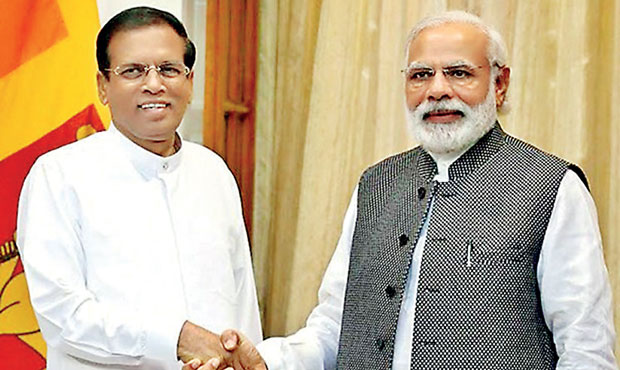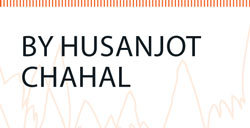26 May 2017 - {{hitsCtrl.values.hits}}

 On May 11, Prime Minister Narendra Modi visited Sri Lanka to attend the International ‘Vesak Day’ celebrations, just two weeks after Sri Lankan Prime Minister Ranil Wickremesinghe’s five-day visit to New Delhi. PM Modi’s visit marked the seventh interaction between the Indian and Sri Lankan heads of state since 2015, which is suggestive of vigorous high-level
On May 11, Prime Minister Narendra Modi visited Sri Lanka to attend the International ‘Vesak Day’ celebrations, just two weeks after Sri Lankan Prime Minister Ranil Wickremesinghe’s five-day visit to New Delhi. PM Modi’s visit marked the seventh interaction between the Indian and Sri Lankan heads of state since 2015, which is suggestive of vigorous high-level
political engagement.
This political activism has mostly aimed at enhancing bilateral relations through increased economic, investment and development cooperation. Even though the need for engagement has remained strong, in practice, very little has been achieved on the economic front. Given the current trajectory, even less is expected to materialise on
the ground.
Cumulatively, the only significant economic arrangement realised by India and Sri Lanka in the past two years is the ‘memorandum of understanding (MoU) for cooperation in economic projects’, signed recently during PM Wickremesinghe’s visit to India. Media reports and official interviews, prior to his visit, highlighted the likelihood of an India-Sri Lanka deal for the development of the Trincomalee area as a regional hydrocarbon hub in the Bay of Bengal and eastern Indian Ocean. What ensued instead was the MoU – essentially in the nature of a “roadmap for
the future”.
Apart from outlining a few broader agendas (on the development of the transportation sector, agriculture and livestock, etc), the roadmap sketched out agreements in the power sector (a 50MW Solar Power Plant in Sampur, a regasified 500MW LNG Power Plant, an LNG Terminal/Floating Storage Regasification Unit in Colombo/Kerawalapitiya).
With Sri Lanka facing an acute power crisis, the emphasis on energy projects is no surprise. The spotlight on the proposed joint venture to develop the World War II-era oil storage facility in Trincomalee remains. While listing agendas, however, the roadmap remains oblivious to past trends and current realities.
The history of Indian involvement in Sri Lanka’s power sector provides a grim picture held back by domestic political concerns and a sluggish bureaucracy. For instance, the Sampur power plant, originally proposed as a coal-based project, has been in the pipeline since 2006 and still awaits execution. It has witnessed a series of delays for various reasons, including repeated requests by Colombo to change the location of the project due to the changes in local socio-economic conditions, mainly related to resettlement of Tamil families displaced by war. With most of the resettlement work still remaining, any new venture in Sampur will have a guaranteed pool of opposition from at least one section of the
Lankan population.
A major roadblock for Indian economic engagement in Sri Lanka is, and has been, the prevailing trust deficit amongst its people vis-à-vis India. There have been negative perceptions about India’s role on the island, for instance, with regard to tying “their only supply of cooking gas or petroleum” to New Delhi’s geopolitical games.
The April 2017 strikes by the workers of the Ceylon Petroleum Corporation (CPC) against the joint development of the Trincomalee oil farms serves as another instance indicating entrenched resistance to economic cooperation with India. The fact that it practically prevented PM Wickremesinghe from signing the Trincomalee deal during his India visit, followed by President Sirisena’s official assurance that no deals would be signed during PM Modi’s visit to Sri Lanka, indicates the political strength of
such resistance.
With particular reference to Trincomalee, besides tackling apprehensions, there is a serious need to address stakeholder concerns about project ownership and operation. In 2003, as part of an MoU signed by the CPC and Indian Oil Corporation (IOC), India’s oil subsidiary in Sri Lanka – Lanka IOC (LIOC) – obtained a 35-year lease to develop the China Bay (Trincomalee) tank farm, with a total of 99 tanks.
However, implementation of the MoU was marred with reservations expressed by the CPC on the procedural aspects of implementation and against providing exclusive right to LIOC to run the installation. Due to internal political reasons, the lease agreement was not implemented in totality, such that LIOC has been able to use only 14 tanks in the lower farm area and the remaining 84 are unused.
The Common Workers Union (CWU) of the CPC alleges that since the lease agreement had to be signed within a period of six months, and was not signed, it is not legal. On the other hand, while speaking about the recently signed MoU, India’s Ministry of External Affairs has been clear in stating that Lanka IOC has had the rights to develop the tank farm since 2003 and the agreement to now develop the upper tank farm as a joint venture comes in light of “our spirit of partnership”. These differences in the narrative could be a recipe for conflict and needs to be addressed sensitively if a fruitful partnership is intended.
The India-Sri Lanka roadmap for cooperation in economic projects is, at best, a good first step since 2015 that has come after significant initial delays. Implementing its agenda will be a complex process. Nothing short of a serious attempt to pace the process of concluding agreements, learning from past lessons, reaching out to bridge the trust deficit and addressing stakeholder concerns in various projects, will enable forward movement.
(Husanjot Chahal is a Researcher and Programme Director at SEARP, IPCS)
08 Jan 2025 42 minute ago
08 Jan 2025 1 hours ago
08 Jan 2025 3 hours ago
08 Jan 2025 4 hours ago